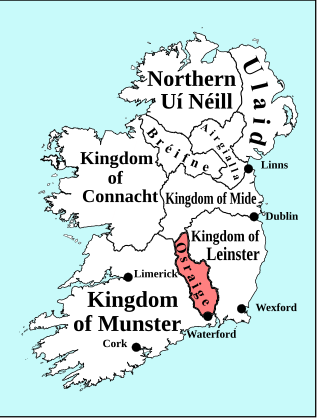Related Research Articles

Uí Fhiachrach Aidhne was a kingdom located in what is now the south of County Galway.
Gilla Íosa Mor mac Donnchadh MacFhirbhisigh was a historian, scribe and poet of the learned Clan MacFhirbhisigh based at Lackan in Tír Fhíacrach, now part of County Sligo. He was the chief compiler of the Yellow Book of Lecan and the Great Book of Lecan, both of which are valuable literary and historical texts.
MacFirbis, also known as Forbes, was the surname of a family of Irish hereditary historians based for much of their known history at Lecan, Tireragh. They claimed descent from Dathí (d.418?/428?), said to be one of the last pagan Kings of Connacht, and were thus one of the many families who sprang from the Uí Fiachrach dynasty. The progenitors of the MacFirbis family descend from Amhailgadh, whose brothers included Fiachra Ealg and Eocha Breac.

The kings of Osraige reigned over the medieval Irish kingdom of Osraige from the first or second century AD until the late twelfth century. Osraige was a semi-provincial kingdom in south-east Ireland which disappeared following the Norman Invasion of Ireland. A number of important royal Ossorian genealogies are preserved, particularly MS Rawlinson B502, which traces the medieval Mac Giolla Phádraig dynasty back through Óengus Osrithe, who supposedly flourished in the first or second century. and one in the Book of Leinster. Recent analysis of ninth and tenth century regnal succession in Osraige has suggested that in peaceful times, kingship passed primarily from eldest to youngest brother, before crossing generations and passing to sons and nephews.
Mac Aodhagáin, is an Irish Gaelic clan of Brehons who were hereditary lawyers - firstly to the Ó Conchobhair Kings of Connacht, and later to the Burkes of Clanricarde.

The Kingdom of Breifne or Bréifne, anglicized as Breffny, was a medieval overkingdom in Gaelic Ireland. It comprised what is now County Leitrim, County Cavan and parts of neighbouring counties, and corresponds roughly to the Roman Catholic Diocese of Kilmore. It had emerged by the 10th century, as a confederation of túatha headed by an overking drawn from the Uí Briúin Bréifne.
The Yellow Book of Lecan, or TCD MS 1318, is a late medieval Irish manuscript. It contains much of the Ulster Cycle of Irish mythology, besides other material. It is held in the Library of Trinity College Dublin.
Events from the year 1418 in Ireland.
Leabhar na nGenealach is a massive genealogical collection written mainly in the years 1649 to 1650, at the college-house of St. Nicholas' Collegiate Church, Galway, by Dubhaltach MacFhirbhisigh. He continued to add material until at least 1666, five years before he was murdered in 1671. The original 17th century manuscript was bequeathed to University College Dublin (UCD), by Dublin solicitor Arthur Cox in 1929, and can be consulted in UCD Library Special Collections. The manuscript can be viewed online at Irish Script on Screen, which is available in English, and in Irish. Leabhar na nGenealach, was reprinted, and published in a five volume edition in Dublin in 2004 as The Great Book of Irish Genealogies.
Cían d'Fhearaibh Bolg, last King of the Senchineoil of Magh Senchineoil, now in County Galway, Ireland.
Irish genealogy is the study of individuals and families who originated on the island of Ireland.
Maghnus Ua Conchobair, Prince of Connacht, died 1181.
Amhlaoibh Mór mac Fir Bhisigh, Irish poet, cleric and historian, died 1138.
Fear Bisigh mac Domhnaill Óig, eponymous ancestor of Clann Mac Fir Bhisigh of Connacht, fl. 11th century.
Caomhán mac Connmhach, Eponym and Ancestor of the Clan Ó Caomháin of north Connacht, fl. 9th-10th century. The surname is variously anglicised as Keevan, Kevane, Keeveen, Keevans, Keaven, Keavan, Cavan.
The Uí Fiachrach were a royal dynasty who originated in, and whose descendants later ruled, the coicead or fifth of Connacht at different times from the mid-first millennium onwards. They claimed descent from Fiachrae, an older half-brother of Niall Noigiallach or Niall of the Nine Hostages. Fiachrae and his two full brothers, Brion and Ailill, were the collective ancestors of the Connachta dynasty that eventually became the new name of the province. Their mother was Mongfind.
Gilla may refer to:
Brian Breaghach Mág Samhradháin, was chief of the McGovern Clan of Tullyhaw, County Cavan from 1272 to 3 May 1294.
Gíolla Íosa Mór Mág Tighearnán was chief of the McKiernan Clan and Baron or Lord of Tullyhunco barony, County Cavan from c. 1269 until his death in 1279.
References
- The Celebrated Antiquary, Nollaig Ó Muraíle, Maynooth, 1996.